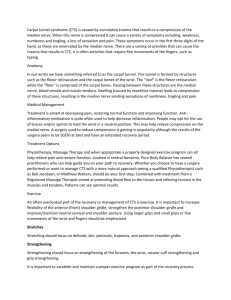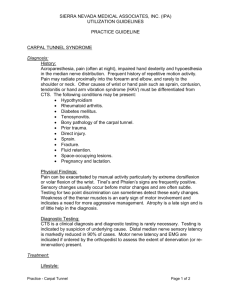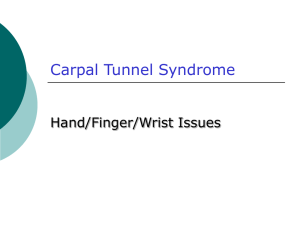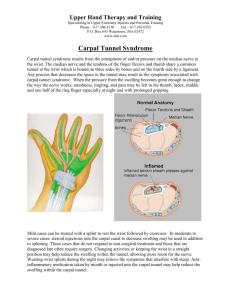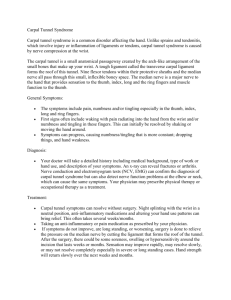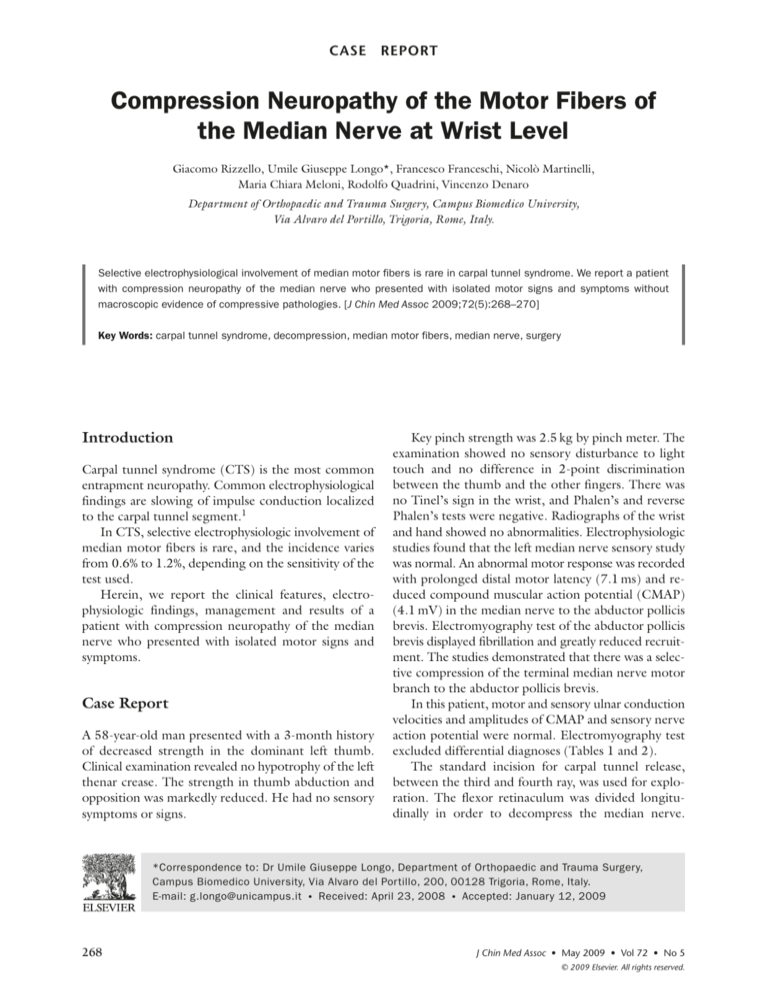
CASE
REPORT
Compression Neuropathy of the Motor Fibers of
the Median Nerve at Wrist Level
Giacomo Rizzello, Umile Giuseppe Longo*, Francesco Franceschi, Nicolò Martinelli,
Maria Chiara Meloni, Rodolfo Quadrini, Vincenzo Denaro
Department of Orthopaedic and Trauma Surgery, Campus Biomedico University,
Via Alvaro del Portillo, Trigoria, Rome, Italy.
Selective electrophysiological involvement of median motor fibers is rare in carpal tunnel syndrome. We report a patient
with compression neuropathy of the median nerve who presented with isolated motor signs and symptoms without
macroscopic evidence of compressive pathologies. [J Chin Med Assoc 2009;72(5):268–270]
Key Words: carpal tunnel syndrome, decompression, median motor fibers, median nerve, surgery
Introduction
Carpal tunnel syndrome (CTS) is the most common
entrapment neuropathy. Common electrophysiological
findings are slowing of impulse conduction localized
to the carpal tunnel segment.1
In CTS, selective electrophysiologic involvement of
median motor fibers is rare, and the incidence varies
from 0.6% to 1.2%, depending on the sensitivity of the
test used.
Herein, we report the clinical features, electrophysiologic findings, management and results of a
patient with compression neuropathy of the median
nerve who presented with isolated motor signs and
symptoms.
Case Report
A 58-year-old man presented with a 3-month history
of decreased strength in the dominant left thumb.
Clinical examination revealed no hypotrophy of the left
thenar crease. The strength in thumb abduction and
opposition was markedly reduced. He had no sensory
symptoms or signs.
Key pinch strength was 2.5 kg by pinch meter. The
examination showed no sensory disturbance to light
touch and no difference in 2-point discrimination
between the thumb and the other fingers. There was
no Tinel’s sign in the wrist, and Phalen’s and reverse
Phalen’s tests were negative. Radiographs of the wrist
and hand showed no abnormalities. Electrophysiologic
studies found that the left median nerve sensory study
was normal. An abnormal motor response was recorded
with prolonged distal motor latency (7.1 ms) and reduced compound muscular action potential (CMAP)
(4.1 mV) in the median nerve to the abductor pollicis
brevis. Electromyography test of the abductor pollicis
brevis displayed fibrillation and greatly reduced recruitment. The studies demonstrated that there was a selective compression of the terminal median nerve motor
branch to the abductor pollicis brevis.
In this patient, motor and sensory ulnar conduction
velocities and amplitudes of CMAP and sensory nerve
action potential were normal. Electromyography test
excluded differential diagnoses (Tables 1 and 2).
The standard incision for carpal tunnel release,
between the third and fourth ray, was used for exploration. The flexor retinaculum was divided longitudinally in order to decompress the median nerve.
*Correspondence to: Dr Umile Giuseppe Longo, Department of Orthopaedic and Trauma Surgery,
Campus Biomedico University, Via Alvaro del Portillo, 200, 00128 Trigoria, Rome, Italy.
E-mail: g.longo@unicampus.it
Received: April 23, 2008
Accepted: January 12, 2009
●
268
●
J Chin Med Assoc • May 2009 • Vol 72 • No 5
© 2009 Elsevier. All rights reserved.
Neuropathy of the median nerve
Table 1. Preoperative distal motor latency and CMAP values from
the abductor pollicis brevis after stimulation at the wrist
Nerve/site
Latency (ms)
CMAP (mV)
Left median/APB
Wrist
7.1
4.1
Right median/APB
Wrist
3.7
8.3
Left ulnar/ADM
Wrist
3.1
5.8
Right ulnar/ADM
Wrist
3.2
5.6
CMAP = compound muscular action potential; APB = abductor pollicis brevis;
ADM = abductor digiti minimi.
Table 2. Postoperative distal motor latency and CMAP values
from the abductor pollicis brevis after stimulation at the wrist
(12 weeks after surgery)
Nerve/site
Latency (ms)
CMAP (mV)
Left median/APB
Wrist
3.5
7.9
Right median/APB
Wrist
3.49
8.3
Left ulnar/ADM
Wrist
3.31
5.8
Right ulnar/ADM
Wrist
3.28
5.9
CMAP = compound muscular action potential; APB = abductor pollicis brevis;
ADM = abductor digiti minimi.
Further exploration to the junction of the motor
branch did not reveal macroscopic evidence of anatomic
variations of the median nerve (Figure 1). Ten weeks
after surgery, the patient had no difficulty in using his
left hand, and key pinch strength had improved to
6.5 kg.
Electromyography test performed 12 weeks after
surgery revealed a reduction in distal motor latency
(3.5 ms) and an increase in CMAP (7.9 mV).
Discussion
Isolated motor branch involvement is described in the
literature. Ganglion cyst is frequently reported to be
an etiologic factor in isolated motor branch compression.2–6
Bennet and Crouch7 reviewed 8 cases of concomitant or independent compression of the recurrent
motor branch of the median nerve and found that
J Chin Med Assoc • May 2009 • Vol 72 • No 5
Figure 1. Intraoperative photograph.
this entity appears to exist in the presence of carpal
tunnel symptomatology or as independent compression. Evans et al reported a case in which anatomy of
the thenar eminence predisposed the median motor
branch to extrinsic compression.8
It is generally accepted that median nerve sensory
conduction is more sensitive than motor conduction
in the electrodiagnosis of CTS. Therefore, motor segmental conduction can be more abnormal than sensory.9 Repaci et al2 found that 31 patients out of 2,727
with CTS were affected by prolonged median distal
motor latency with normal sensory conduction velocity. In mild to moderate CTS, motor fibers are more
commonly affected than was originally thought.10
In our case, although the clinical and electrophysiologic findings suggested a selective compression of the
thenar branch, we did not find either selective compression of the thenar branch or anatomic course variation of the median nerve and its branch in the carpal
tunnel at surgery. The early effects of compression of
the nerve in CTS are not uniform, and the anteromedially and anterolaterally situated fasciculi appear to
be more susceptible compared to fibers located more
centrally.11,12 However, the lack of macroscopic evidence does not necessarily imply the absence of microscopic evidence.
Prevalent or exclusive motor fibers involved in CTS
may be related to the intraneural topography of motor
fibers before the emergence of the recurrent motor
thenar branch. The motor fibers are located beneath the
transverse ligament, in the most volar-radial quadrant.
In a previous anatomic dissection study, Mackinnon
and Dellon13 found that the motor thenar branch arose
in 60% of cases from the extreme radial part of the
nerve; in 18%, the motor branch arose from a location
between the extreme radial volar and the central aspect
of the nerve.14–16 This may explain why, in some cases,
269
G. Rizzello, et al
the motor fibers to the abductor pollicis brevis, located
anterolaterally in the median nerve, can be injured first.
References
1. Jablecki CK, Andary MT, So YT, Wilkins DE, Williams FH.
Literature review of the usefulness of nerve conduction studies
and electromyography for the evaluation of patients with carpal
tunnel syndrome. AAEM Quality Assurance Committee. Muscle
Nerve 1993;16:1392–414.
2. Repaci M, Torrieri F, Di Blasio F, Uncini A. Exclusive electrophysiological motor involvement in carpal tunnel syndrome.
Clin Neurophysiol 1999;110:1471–4.
3. Kobayashi N, Koshino T, Nakazawa A, Saito T. Neuropathy of
motor branch of median or ulnar nerve induced by midpalm
ganglion. J Hand Surg 2001;26A:474–7.
4. Jensen TT. Isolated compression of the motor branch of the
median nerve by a ganglion: case report. Scand J Plast Reconstr
Surg Hand Surg 1990;24:171.
5. Crowley B, Gschwind CR, Storey C. Selective motor neuropathy
of the median nerve caused by a ganglion in the carpal tunnel.
J Hand Surg [Br] 1998;23:611–2.
6. Kato H, Ogino T, Nanbu T, Nakamura K. Compression neuropathy of the motor branch of the median nerve caused by
palmar ganglion. J Hand Surg [Am] 1991;16:751–2.
7. Bennet JB, Crouch CC. Compression syndrome of the recurrent motor branch of the median nerve. J Hand Surg 1982;
7:407–9.
270
8. Evans MD, O’Connor D, Wood SH. Squash motor branch:
extrinsic compression of the motor branch of the median nerve.
Eur J Plast Surg 2000;23:294–6.
9. Di Guglielmo G, Torrieri F, Repaci M, Uncini A. Conduction
block and segmental velocities in carpal tunnel syndrome.
Electroencephalogr Clin Neurophysiol 1997;105:321–7.
10. Ginanneschi F, Mondelli M, Dominici F, Rossi A. Changes in
motor axon recruitment in the median nerve in mild carpal
tunnel syndrome. Clin Neurophysiol 2006;117:2467–72.
11. Uncini A, Lange DJ, Solomon M, Soliven B, Meer J, Lovelace
RE. Ring finger testing in carpal tunnel syndrome: a comparative study of diagnostic utility. Muscle Nerve 1989;12:735–41.
12. Terzis S, Paschalis C, Metallinos IC, Papapetropoulos T. Early
diagnosis of carpal tunnel syndrome: comparison of sensory
conduction studies of four fingers. Muscle Nerve 1998;21:
1543–5.
13. Mackinnon SE, Dellon AL. Anatomic investigations of nerves
at the wrist: I. Orientation of the motor fascicle of the median
nerve in the carpal tunnel. Ann Plast Surg 1988;21:32–5.
14. Chen YC, Wang SJ, Shen PH, Huang GS, Lee HS, Wu SS.
Intraosseous ganglion cyst of the capitate treated by intralesional curettage, autogenous bone marrow graft and autogenous fibrin clot graft. J Chin Med Assoc 2007;70:222–6.
15. Cheung JW, Shyu JF, Teng CC, Chen TH, Su CH, Shyr YM,
Wang JJ, et al. The anatomical variations of the palmar cutaneous branch of the median nerve in Chinese adults. J Chin
Med Assoc 2004;67:27–31.
16. Fu PK, Hsu HY, Wang PY. Delayed reversible motor neuronopathy caused by electrical injury. J Chin Med Assoc 2008;71:
152–4.
J Chin Med Assoc • May 2009 • Vol 72 • No 5

